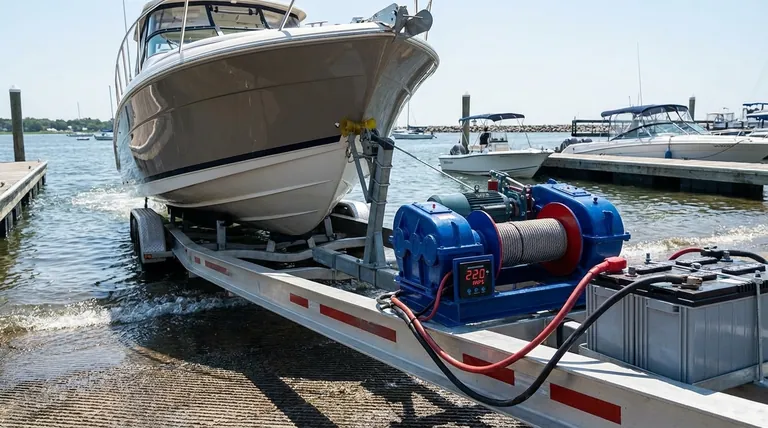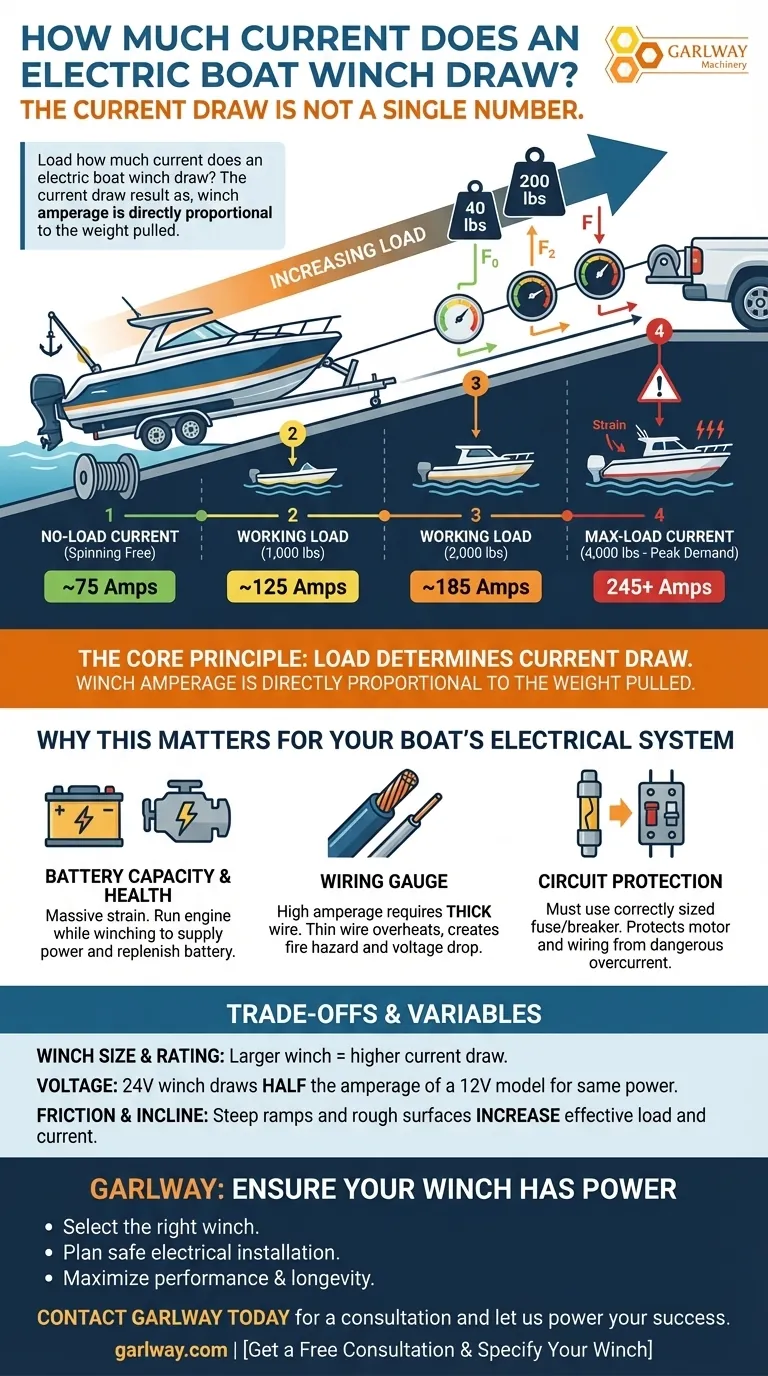The current draw of an electric boat winch is not a single number; it varies dramatically based on the load. Based on performance data for a typical 12V winch, the current can range from approximately 75 amps with no load to over 245 amps when pulling a heavy, 4,000-pound load.
The most critical takeaway is that a winch's amperage draw is directly proportional to the amount of weight it is pulling. Understanding this relationship is essential for designing a safe and reliable electrical system for your boat.

The Core Principle: Load Determines Current Draw
An electric winch motor works harder when the load increases, and this increased effort demands more electrical current from your battery. Let's break down how this works using a common 12V winch as an example.
No-Load Current
When the winch is operating without any weight on the line, it's only spinning the drum and gear train. This still requires a significant amount of power.
For a typical winch, this baseline or no-load draw is around 75 amps.
Working Load Current
This is the range where most winching occurs, such as retrieving a boat onto its trailer. As the load increases, so does the current.
Pulling a 1,000-pound load might draw 125 amps, while a 2,000-pound load could increase that demand to 185 amps.
Max-Load Current
As the winch approaches its maximum rated capacity, the motor is under extreme strain, causing the current draw to spike sharply.
Pulling a 4,000-pound load can push the current draw to 245 amps or more. This peak demand is the most important number for sizing your electrical system.
Why This Matters for Your Boat's Electrical System
A winch is one of the highest-demand accessories you can install. Ignoring its power requirements can lead to poor performance, damaged equipment, or even a fire.
Battery Capacity and Health
A massive current draw puts a heavy strain on your battery. A weak or undersized battery may not be able to supply the peak current, causing the winch to stall.
It is always recommended to run your boat's engine while operating the winch. This allows the alternator to help supply power and replenish the battery.
Wiring Gauge
High amperage requires thick, heavy-gauge electrical wire. Using wire that is too thin for the current and the length of the run will cause it to overheat, creating a serious fire hazard.
It also leads to a significant voltage drop, which starves the winch motor of power and reduces its pulling capability.
Circuit Protection
A winch circuit must be protected by a correctly sized fuse or circuit breaker. This device is critical for safety and is designed to cut power if the current exceeds a safe level, protecting both the winch motor and the wiring.
Understanding the Trade-offs and Variables
The example numbers are a useful guide, but the exact current draw depends on your specific equipment and situation.
Winch Size and Rating
A larger winch rated for a 10,000-pound load will draw significantly more current at every level than a smaller one rated for 3,000 pounds.
Voltage (12V vs. 24V)
For the same amount of pulling power, a 24-volt winch will draw half the amperage of a 12-volt model. This allows for thinner wiring and can be more efficient, but requires a 24V power system.
Friction and Incline
The "load" isn't just the weight of your boat. Pulling a boat up a steep ramp or dragging it across a rough surface like sand increases the effective load, which in turn increases the current draw.
How to Plan Your Winch Installation
To ensure a safe and effective setup, you must match your electrical system to the winch's specific demands.
- If your primary focus is safety and reliability: Select your wire gauge and circuit breaker based on the maximum possible current draw listed on the winch manufacturer's specification sheet.
- If your primary focus is performance and longevity: Ensure your battery is fully charged and in excellent health, and always run the engine during heavy winching operations.
- If you are selecting a new winch: Do not estimate. Always consult the manufacturer's technical data for the specific model to find its exact current draw under various loads.
Ultimately, treating your winch as a high-performance system and installing it correctly will ensure it works when you need it most.
Summary Table:
| Load Condition | Approximate Current Draw (12V System) |
|---|---|
| No Load (Spinning Free) | ~75 Amps |
| 1,000-Pound Load | ~125 Amps |
| 2,000-Pound Load | ~185 Amps |
| 4,000-Pound Load (Max Load) | 245+ Amps |
Ensure Your Boat Winch Has the Power It Needs
Don't let an undersized electrical system cause your winch to fail when you need it most. GARLWAY specializes in robust construction and marine machinery, offering reliable winches designed for demanding applications.
We can help you:
- Select the right winch for your boat and trailer weight.
- Plan a safe electrical installation with correct wiring and circuit protection.
- Maximize performance and longevity with professional guidance.
Our expertise ensures your equipment operates safely and effectively. Contact GARLWAY today for a consultation and let us power your success.
Get a Free Consultation & Specify Your Winch
Visual Guide

Related Products
- Electric 120V Boat Winch by Badlands
- Electric Hoist Winch Boat Anchor Windlass for Marine Applications
- Heavy Duty Electric Boat Winch Windlass Anchor
- Electric and Hydraulic Winch for Heavy Duty Applications
- Warn Winch Windlass Boat Trailer Winch
People Also Ask
- What are the power source options for electric winches? Choose the Right Power for Your Job
- How to choose a boat winch? A Guide to Selecting the Right Trailer or Anchor Winch
- What are marine electric winches and their characteristics? Key Features for Reliable Maritime Operations
- What does a boat winch attach to? Secure Your Boat with the Right Mounting System
- How do electric boat winches work? Unlock Effortless Launching & Retrieval







